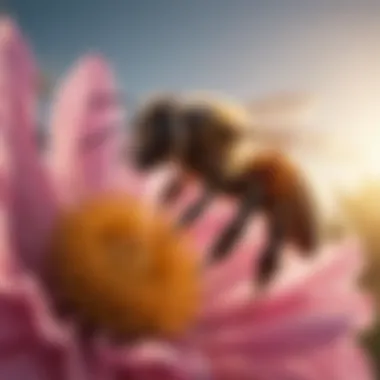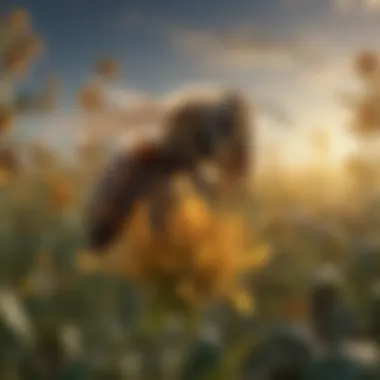The Importance of Bee Pollination in Agriculture


Intro
The role of bee pollination services in agriculture cannot be overstated. Pollinators, particularly bees, play a crucial part in the ecosystem that underpins food production. As farmers and agriculture enthusiasts, understanding how these tiny creatures contribute to the success of our crops is fundamental. From the fruits we eat to the nuts we enjoy, many of our most beloved foods depend on the pollination services that bees provide.
This article will explore key concepts, recent innovations, and practical applications surrounding bee pollination services, creating a comprehensive narrative tailored for all those with a stake in agriculture. The aim is to clearly demonstrate why bees are not just insects flitting about; they are key players in creating and sustaining food systems.
Let's dive deeper into the context of this vital relationship.
Understanding Pollination
Pollination sits at the very heart of agricultural success. It’s a pivotal process that forms the bridge between the flowering plants and the food we rely on. Without it, much of the world’s agriculture would crumble. At its core, pollination involves transferring pollen from the male structures of a flower to the female structures. This is where the magic happens, leading to the formation of seeds and, subsequently, fruit.
From an ecological standpoint, healthy pollination dynamics ensure a rich diversity among plant species. This diversity is essential for creating resilient ecosystems that can withstand pests, diseases, and environmental changes. On the economic front, effective pollination management can significantly boost crop yields, supporting food production and farmer livelihoods. In practical terms, it’s not just about the act itself, but also about recognizing the integral role of various pollinators, especially bees.
Understanding this relationship is essential for anyone invested in agriculture. It helps in grasping not only how to manage crops effectively but also how to strategize against the risks faced by pollinators.
The decline in bee populations directly threatens agricultural productivity. Acknowledging their role is more than an academic exercise; it’s about ensuring the future of our food systems.
Knowing which plants require pollination and the types of pollinators involved brings a layer of depth to agriculture that farmers can leverage. It allows them to optimize their yields and ensure they are nurturing the right environments to protect these invaluable creatures.
The Economics of Bee Pollination
The intricate relationship between bee pollination and agriculture isn't just about buzzing creatures and blooming plants; it's a financial powerhouse. Understanding the economics of bee pollination is crucial for anyone invested in farming. It’s like the backbone of many crops, contributing significantly to both direct and indirect economic benefits. The very act of pollination by bees supports agricultural productivity, which has numerous implications for economies at all scales—from local markets to global food supply chains.
By prioritizing bee health and their habitats, farmers can tap into a number of economic advantages. This section unfolds the various aspects of the economic significance of bees in agriculture.
Valuing Pollinator Services
Evaluating the economic value of bee pollination involves more than just counting flowers. It's a detailed process that delves into how much pollinators contribute to the agricultural sector. According to some studies, the dollar value of pollination can reach into the billions worldwide, with bees playing a pivotal role.
Here are some key factors that help in valuing these services:
- Market Value of Pollinated Crops: Pollinators boost the yields of fruits, vegetables, and nuts, creating higher market prices for farmers. Crops like almonds, berries, and cucumbers depend heavily on bee activity.
- Cost of Alternative Methods: When bee populations decline, farmers often need to resort to artificial pollination techniques, which can amplify costs significantly.
- Ecosystem Services: Beyond just food production, bees contribute indirectly by supporting healthy ecosystems that provide benefits like soil fertility and pest control.
These factors illustrate the substantial economic winds that flow from bee pollination, showing that healthy bee populations are economically beneficial for farmers and the broader agriculture economy alike.
The Contribution to Crop Yields
Crop yields hinge on a number of elements, but the pollination process provided by bees is one of the most significant. When bees do their dance among the flowers, they facilitate the fertilization that enables plants to make seeds and fruit. Studies point out that approximately 75% of global food crops are reliant on bee pollination to some degree.
For instance, let's take apples and blueberries. A healthy bee colony can increase fruit size and improve quality, often leading to a 50% increase in yield for these crops. This not only helps make food more abundant but also increases the profitability for farmers.
- Quality of Produce: Not only do yields increase, but the quality of the produce improves, allowing for fetch higher prices on the market.
- Biodiversity Support: Pollination by bees promotes biodiversity in crops, which can lead to a more resilient agricultural system, stabilizing harvests against pests and climate change.
With all of these benefits, it’s clear that bees are not just a nice addition to the garden but an essential cog in the wheel of agricultural success.
Economic Implications of Bee Decline
The decline in bee populations raises serious concerns not only for the ecology but also for economics. Stagnant or declining bee numbers can lead to food shortages, skyrocketing prices, and economic instability.
The implications manifest in several ways, including:


- Increased Costs: Reduced bee activity leads to lower crop yields, prompting farmers to spend more on artificial pollination. This adds additional strain on operational budgets, squeezing margins that are already thin.
- Market Volatility: Less production for certain crops can lead to fluctuating prices, impacting food accessibility. This is particularly troublesome for low-income communities that depend on affordable produce.
- Long-term Effects on Farming Practices: Continuous decline can push farmers to abandon certain crops altogether, leading to shifts in agricultural practices and potential loss of income over time.
In summary, the health of bee populations is not merely a topic for conservationists; it's a pressing economic framework that affects everyone, especially those in agriculture.
By understanding the economic role of bees, farmers and stakeholders can make informed decisions about practices that support not only bee populations but also their own livelihoods.
Types of Bees and Their Roles
When it comes to agriculture, bees are often the unsung heroes. Their role in pollination is integral, not just for the plants but for the entire ecosystem. Understanding the different types of bees and what they bring to the table is essential for farmers and enthusiasts alike. Each type of bee has its unique characteristics and contributes differently to the pollination process, impacting crop yields and plant diversity. Here’s a closer look at the primary players in the realm of pollination.
Honey Bees
Honey bees play a significant role in agricultural pollination. Often kept in hives by beekeepers, these social insects can travel several miles from their home to gather nectar and pollen. Their ability to communicate with each other through a form of dance allows them to share the location of abundant food sources. This is beneficial for farmers, as the presence of honey bees can lead to improved fruit set and higher yields.
Honey bees are responsible for pollinating approximately one-third of the food we consume.
While their impact is immense, honey bees are not native to many regions; they originated from Europe. This means that their dependency on human management makes them vulnerable to threats such as pesticides and habitat loss. Farmers can optimize their agricultural successes by understanding the life cycle and habits of honey bees, particularly how to maintain healthy colonies.
Native Bees
Native bees are critical players in the pollination game. They vary widely in size, color, and nesting behavior, with thousands of species existing worldwide. Unlike honey bees, which live in large hives, many native bees are solitary creatures. For instance, mason bees and leafcutter bees have become champions in specific agricultural settings due to their efficiency and strong foraging abilities.
These bees are often better pollinators for certain crops, like blueberries and almonds, when compared to honey bees. Native bees also pollinate plants that honey bees may overlook, enhancing biodiversity in the ecosystem. Therefore, fostering environments that support native bee populations can lead to healthier crops and more resilient farming operations.
Bumblebees
Bumblebees, with their fuzzy appearances and larger sizes, bring an entirely different dynamic to the pollination process. They are known for their ability to perform buzz pollination, a technique that vibrates flowers to release pollen. This technique is especially useful for crops such as tomatoes and peppers, where other bees may struggle to access pollen.
Moreover, bumblebees are active at lower temperatures and in more challenging weather conditions, enabling them to work when honey bees might not venture out. This resilience can be a game-changer for farmers looking for consistent pollination, regardless of climatic conditions. However, bumblebee populations are also susceptible to environmental changes, which raises concerns about crop reliability.
Solitary Bees
As the name suggests, solitary bees do not nest in colonies. Instead, each female builds her own nest, which can be found in various locations, including underground or in plant stems. There are numerous species of solitary bees. Some of the featured types include mason bees, which use mud to construct their nests, and mason bees, known for their rapid pollination efficiency.
Solitary bees are often underestimated in their importance to agriculture. They can be remarkably effective at pollinating flowering crops. Their numbers tend to be more diverse than those of honey bees, which can settle in spaces that honey bees might avoid. Therefore, embracing a variety of bee species on farms can lead to enhanced pollination success and crop resilience.
To ensure a sustainable future for agriculture, it’s crucial for farmers and stakeholders to appreciate and protect these various bee species. Each one contributes to the overall health of the ecosystem, and by fostering a habitat that supports all these bees, we safeguard our food systems and biodiversity.
Factors Influencing Bee Health
Bee health is paramount to the ecosystem, especially in agriculture where bee pollination services significantly enhance crop yields. Understanding the various factors that affect bee health can help in devising effective strategies to sustain bee populations. This section delves into three critical aspects: pesticides, habitat loss, and climate change. Each of these factors poses unique challenges to bee survival and productivity, emphasizing the need for targeted actions to mitigate their impacts.
Pesticides and Their Impact
Pesticides are widely used in agriculture to control pests and boost crop production. However, what many may overlook is the detrimental effect these chemicals can have on bees. Varieties such as neonicotinoids can impair bees' cognitive functions, hindering their ability to communicate and navigate back to hives. This adversely impacts their pollination efficiency. It’s not just the direct exposure that harms them; residues in pollen and nectar can lead to slow, chronic effects that jeopardize colony health over time.
Research indicates that when bees come into contact with pesticides, their foraging patterns are disrupted, leading to inadequate pollination of plants. Moreover, when multiple pesticides are used, the combined effect can be devastating, creating a cocktail that bee populations struggle to survive.
"Bee populations are in decline due to the accumulating effects of pesticide exposure, creating a silent crisis in agriculture."
Habitat Loss and Fragmentation


Habitat loss is another significant factor contributing to the declining health of bees. Urbanization, industrial development, and agricultural expansion often fragment natural habitats, reducing the availability of foraging resources. Bees require diverse and plentiful sources of nectar and pollen; when habitats are converted to monocultures, they face food scarcity.
Moreover, fragmented habitats prevent bees from accessing nesting sites, thus affecting reproduction. Once vibrant landscapes teem with flowers now resemble wastelands, incapable of supporting healthy bee populations. This loss of biodiversity directly correlates with reduced pollination services, impacting crop yields and food security.
Climate Change Effects
Climate change has far-reaching implications on bee health and their foraging behaviors. Rising temperatures can alter flowering times and patterns, resulting in mismatched timing between when plants bloom and when bees are active. If bees can’t find food, their survival rates decrease, leading to diminished populations.
Furthermore, extreme weather events, such as prolonged droughts or heavy rainfall, can disrupt both habitat stability and bee movements. As climate shifts push certain flower species towards extinction, bees that depend on them are also threatened.
Conservation Strategies for Bees
The decline of bee populations, a pressing issue that has gained considerable attention in recent years, poses significant challenges to agriculture and biodiversity. Conservation strategies for bees are not merely a recommendation; they are essential to sustain both our ecosystems and agricultural productivity. Given the crucial role bees play in pollination, it's imperative to implement effective conservation measures that address their habitat needs, health, and overall well-being. By bolstering bee populations, agricultural stakeholders can enjoy improved crop yields and a healthier environment.
Creating Pollinator-Friendly Habitats
Creating suitable habitats for bees is a cornerstone of conservation strategies. These environments are not simply patches of wildflowers; rather, they are thoughtfully designed spaces that offer a variety of resources. For instance, integrating native plants within agricultural landscapes can enhance biodiversity. Native flowers not only attract local bee species but also provide the necessary nectar and pollen to sustain them.
- Diversify Planting: Planting different types of flowers that bloom at various times ensures bees have access to food throughout the growing season. For example, combining clover with sunflowers or wildflowers can create an attractive buffet.
- Minimize Pesticide Use: Reducing or eliminating chemical pesticides helps protect bees from harmful exposure. Farmers can engage in integrated pest management (IPM) practices, which prioritize non-chemical methods of pest control.
- Maintain Nesting Sites: Bees need places to nest. Leaving patches of bare ground or creating bee hotels can facilitate nesting for solitary bee species, which are often overlooked.
Sustainable Farming Practices
Adopting sustainable farming practices is another critical aspect of conserving bee populations. These practices not only benefit bees but also improve the resilience of agroecosystems. Here are some considerations:
- Crop Rotation: This practice helps in maintaining soil health and reducing disease pressure. Through alternating crops, farmers can promote a more diverse ecosystem that supports bee populations.
- Reduced Tillage: Minimizing soil disturbance preserves ground-nesting habitats and encourages beneficial insects, contributing to healthier ecosystems.
- Cover Cropping: This method protects and enriches the soil while providing additional foraging resources for bees. Selecting flowering cover crops can significantly enhance habitat availability.
Public Awareness and Education
Increasing public awareness and education around bee conservation is crucial for fostering a collective effort toward protecting these vital pollinators. Communities that understand the importance of bees and their declining populations are more likely to engage in conservation efforts. Here are some initiatives that can help build awareness:
- Workshops and Seminars: Offering educational sessions at local community centers or agricultural fairs can help spread knowledge about bee biology, the impact of pesticides, and best practices for supporting bee populations.
- School Programs: Incorporating bee education into school curriculums can instill an appreciation for these insects in younger generations. Programs could include activities like creating bee gardens.
- Social Media Campaigns: Platforms like Facebook and Reddit serve as great channels for sharing information on the importance of bees and how individuals can contribute to their conservation efforts.
As we stand at the crossroads of declining bee populations and unsustainable practices, embracing conservation strategies is not just beneficial — it's essential for the future of agriculture and our planet.
Case Studies in Bee Pollination
Beating the drum for bee pollination services is crucial, especially when we look at real-world examples that showcase their undeniable impact in agriculture. Case studies illuminate the intricate relationship between bees and farming practices, revealing not just the benefits they bring, but also the challenges that emerge in managing these invaluable pollinators.
Successful Pollination Programs
Successful pollination programs are pivotal in enhancing bee effectiveness in agricultural settings. One such example comes from California’s almond orchards. During the almond bloom season, farmers widely rely on honey bees from all over the country. Studies indicate that without adequate pollination services, almond yields would drop significantly, impacting not just farmers but also the entire economy dependent on almond products.
In Washington State, a cooperative approach saw several farmers collaborating to share resources, such as beekeeping equipment and knowledge about bee health. This initiative led to a healthier bee population and improved pollination efficiency across their crops. The result? An increase in productivity that allowed farmers to sell more diversified produce in local markets, ultimately enhancing their livelihoods.
List of key benefits of successful pollination programs:
- Increased yield: Higher quality and quantity of fruits and nuts.
- Cost-effective solutions: Shared resources reduce financial burdens on individual farmers.
- Enhanced biodiversity: Healthier bee populations promote ecological stability.
Innovations in Pollination Management
Innovations in pollination management are crucial as the agricultural landscape continues to shift. One exciting development is the integration of technology, like the use of drones with sensors to monitor bee activity and health. This type of innovation allows farmers to make data-driven decisions about both crop management and bee care. For instance, researchers identified that when drone technology guided bee placement, it significantly increased the pollination rates of crops like blueberries and cherries.


Moreover, certain farms have started practicing Integrated Crop Pollination (ICP). This strategy combines wild bee habitats, honey bees, and management techniques to create a balanced ecosystem that can support various pollinators. An example is the project by Michigan State University that focuses on educating farmers about the importance of maintaining wild blooms throughout the growing season. These blooms not only provide vital food for bees but also enhance the overall health of the pollination system.
- Key Considerations in Innovations:
- Protecting existing bee habitats through conscious farming techniques.
- Investing in local beekeepers to ensure quality pollinator presence in crops.
- Utilizing agricultural technology for smarter resource management.
"The interdependence between agriculture and pollination services is like a dance; each partner must learn the steps to create a harmonious outcome."
Implementing these innovative approaches creates a strong foundation for sustainable agricultural practices while ensuring the health of bee populations. Case studies in bee pollination not only confirm the significance of these services but also offer vital lessons learned and pathways forward for future agricultural practices.
The Future of Bee Pollination Services
The future of bee pollination services is crucial for agriculture and the broader ecosystem. As farmers strive for greater efficiency and productivity, the reliance on these tiny industrious insects is more pertinent than ever. With climate change and habitat loss looming large, keeping their health in the forefront ensures food security for future generations. The upcoming sections will delve deeper into the specific technological advances, necessary policy changes, and the engagement of stakeholders necessary to streamline and enhance bee pollination services.
Technological Advances
Technological innovation could be a game changer for bee pollination services. Various tools and methods are being developed aimed at bolstering bee health and improving their pollination capacity. For example, drone technology is rapidly advancing, offering new ways to monitor bee populations. Farmers might use drones equipped with cameras to track bee behavior and their interaction with crops, identifying areas needing attention.
Furthermore, precision ag techniques can optimize plant health, thereby creating better environments for bee activities. Smart sensors can collect data regarding environmental conditions, pollen availability, and bloom stages. This info is gold for any farmer looking to harness natural pollinators effectively.
"Technological advancements, especially in monitoring and maintenance, present an unprecedented opportunity to enhance the dynamics between bees and agriculture."
Not to forget, advancements in genetic research may provide insights into creating more resilient bee strains. Beekeepers might soon access bees that are more adaptable to changing climates and diseases, therefore ensuring a stable pollination service over time.
Policy and Regulation Changes
Policy frameworks play a pivotal role in the success of bee pollination services. Governments worldwide need to adopt more favorable policies catering to bee health and conservation. Legislation that promotes the establishment of pollinator-friendly areas and safeguards habitats from harmful agricultural practices is essential.
Countries like Germany and France have already taken steps in this direction, banning certain pesticides for the sake of pollinator protection. Implementing more stringent regulations on chemical use can help safeguard these critical pollinators.
Moreover, funding programs that encourage research and development for bee health and pollination techniques are needed. By investing in sustainable practices, authorities can promote an ecosystem where agriculture and pollination services work in tandem, benefiting both farmers and the environment.
Engaging Stakeholders
Engaging various stakeholders is vital for sustaining bee pollination services. It's not just farmers who need to be involved; communities, researchers, and policymakers all have a role to play. The collaborative effort between these groups can lead to a more holistic approach in addressing the challenges faced by bee populations.
Farmers should collaborate with local universities and research institutions to ensure they have access to the latest findings on pollinator health and farm practices. Knowledge exchange is crucial here. Workshops and community programs that include local beekeepers can help spread awareness on the significance of bees, alongside tips for maintaining healthy populations.
Additionally, creating partnerships with environmental NGOs can benefit both farmers and bee populations. These organizations often have the resources and expertise to advocate for sustainable practices while also helping fund pollinator-friendly initiatives.
The End
In wrapping up the discussion on bee pollination services, it becomes glaringly evident how intertwined these small creatures are with the very fabric of agriculture. The significance of this topic cannot be overstated, as bees play a pivotal role in successful crop yields and the overall health of ecosystems.
Summary of Key Points
From the outset, we explored the foundations of how pollination operates, diving into the types of pollination and the crucial role bees play. Understanding that both honey bees and native bee species contribute uniquely to the process is important for any farmer looking to optimize their crop production. We discussed the economic implications of bee decline, making it clear that without robust bee populations, the financial stability of agricultural sectors hangs in the balance.
Moreover, the exploration of factors threatening bee health sheds light on urgent challenges. Habitat loss, climate change, and pesticide use are just a few of the hurdles that need addressing. Conservation strategies were outlined, evidencing how proactive steps can foster healthy bee environments, thus ensuring sustained agricultural productivity.
Call to Action
It's high time that stakeholders across the agricultural landscape—farmers, policymakers, consumers—step up and recognize the critical role bees have. Here’s what can be done moving forward:
- Support Local Beekeepers: Buy honey and other bee-related products from local sources to tighten community bonds and support sustainable practices.
- Practice Sustainable Agriculture: Adopt methods that minimize pesticide usage and promote biodiversity in farming settings.
- Educate and Advocate: Use social media platforms like Facebook and Reddit to spread awareness about the importance of bees. Inform others about how they can contribute to bee conservation.
It is essential that we not only acknowledge but also celebrate the efforts of these humble pollinators. By taking concerted action, we can pave the way for a future that is not only sustainable but thriving, thereby securing food production for generations to come.















